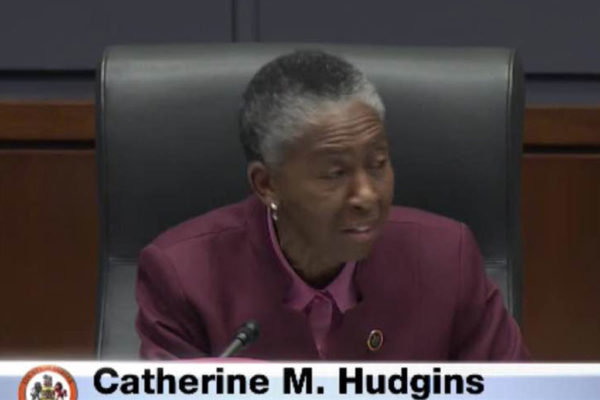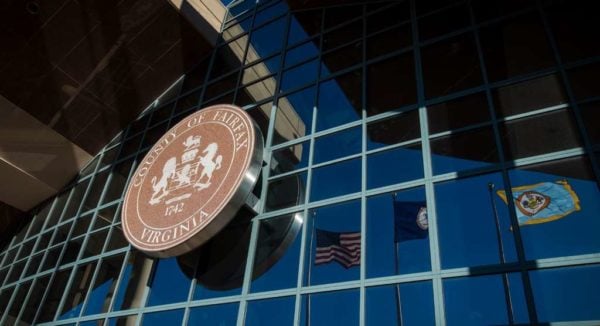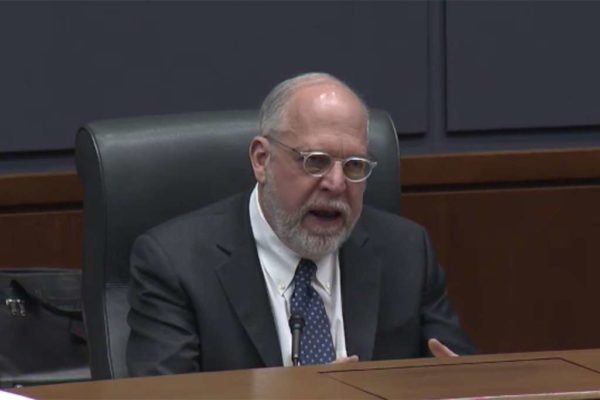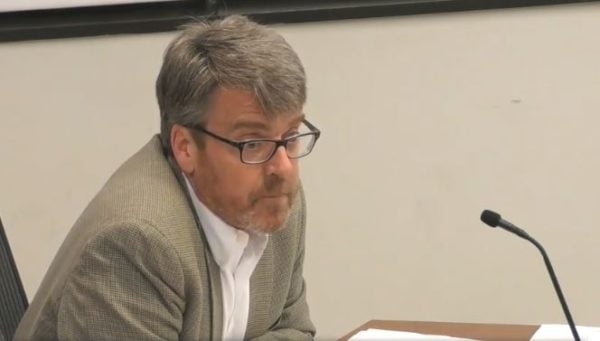The Fairfax County Board of Supervisors unanimously approved Hunter Mill District Supervisor Cathy Hudgins’ motion to “indefinitely defer” the consideration of a proposed zoning amendment.
The zoning ordinance has been a hotly debated issue among Restonians.
It would have increased the maximum allowed population per acre in the Planned Residential Community (PRC) district — Reston’s primary zoning district — from 13 persons to any number up to 15, along with allowing residential development at a density of up to 70 dwelling units per acre in certain areas.
“There are those in the community who do not support this change to the PRC density because they do not support redevelopment of the village centers and are concerned about future growth in Reston,” Hudgins told the board before the vote. “There is also concern that this PRC amendment will somehow support residential development on one or both of the two golf courses in Reston.”
Hudgins also said that misinformation has plagued the push to update the zoning ordinance and thanked the staff for their work educating the community.
“I had hoped that we could have found a way to provide the necessary zoning tool to implement the adopted Reston Plan,” Hudgins said.
Hudgins said that she will work with staff and community representatives to outline a process and timeframe to reexamine the plan for the village centers before reconsidering the PRC amendment — the Planning Commission’s suggested solution.
The vote came shortly after noon on Tuesday (March 5) during the board’s meeting.
Chairman Sharon Bulova told Hudgins that she understands the PRC amendment has been difficult for her and the Reston community.
“This is not easy, and I know that folks have asked for the opportunity to maybe step back and try to revisit the process that will allow things to move forward in a way that has more community engagement and more community support for a path forward,” she said.
Photo via Fairfax County
Updated at 4:45 p.m. — Hunter Mill District Supervisor Cathy Hudgins is expected to “indefinitely defer” the decision tomorrow, according to emails obtained by Reston Now. A reason was not given.
Updated at 4:30 p.m. — A public hearing on a Reston PRC zoning ordinance that was slated for tomorrow will not be held, a Fairfax County staffer told Reston Now.
Earlier: The agenda for the Fairfax County Board of Supervisors’ meeting tomorrow (March 5) just got lighter now that it doesn’t plan to hold a public hearing on a hotly debated issue among Restonians.
The public hearing, which was scheduled to take place after 4:30 p.m. and be the last item on the agenda, will not be happening, a Fairfax County staffer told Reston Now. The staffer was not aware of the reason.
Back in February, Fairfax County’s Planning Commission recommended that the Board of Supervisors deny the specific proposal, which would have increased the maximum allowed population per acre in the Planned Residential Community (PRC) district — Reston’s primary zoning district — in certain areas.
The board is set to authorize advertisements of a public hearing for an ordinance that would establish Economic Revitalization and Redevelopment Zones (ERRZs) throughout the county.
The zones stem from a bill passed by the General Assembly in 2017 that “provides for regulatory flexibility and financial incentives to encourage the private sector to assemble property for economic development purposes,” according to county documents.
The proposed amendment would offer expedited processing of development applications and other regulatory and economic incentives to private sector developers.
The commercial revitalization area of the Lake Anne Village Center would be one of the zones established, along with others including McLean and Springfield, Baileys Crossroads and more.
Photo via Fairfax County Government/Facebook
Voting for Reston Association’s elections begins today for five uncontested seats on the Board of Directors.
Three candidates are incumbents:
- Catherine Baum for a one-year term as the Apartment Owners Representative
- Caren Anton for a one-year term as the Hunters Woods/Dogwood Representative
- John Mooney for a three-year term as the North Point Representative
Tom Mulkerin, a residential real estate agent who has served on the board of the Lakewinds II Cluster Association, is running for a three-year-term At-Large seat.
Aaron Webb, who has served on the board of the Lakeside Cluster, is running for a three-year term for the Lake Anne/Tall Oaks Representative, which is currently filled by Sherri Herbert.
Mooney, Mulkerin, Webb and Anton participated in a candidates’ forum last week where they responded to questions about resource management, Reston’s density cap, the board’s authority and community outreach.
At least 10 percent of eligible voters are needed to make the results official.
The month-long voting period ends on April 1. The results will get announced at the Annual Members’ Meeting in April.
Photos courtesy Reston Association
Fairfax County’s Planning Commission finally weighed in on a controversial zoning ordinance proposal for Reston by recommending that the county’s Board of Supervisors deny the specific proposal, yet take steps to resolve PRC issues with the use of a taskforce.
The zoning ordinance would increase the maximum allowed population per acre in the Planned Residential Community (PRC) district — Reston’s primary zoning district — from 13 persons to any number up to 15, along with allowing residential development at a density of up to 70 dwelling units per acre in certain areas.
Vice Chairman and At-Large Commissioner James Hart, the main person leading the proposal, gave a lengthy speech before the commission voted and approved his motions on the proposal. “We are close to the PRC cap, but the level of pushback we have received has confirmed to me it’s the wrong way to do this amendment,” Hart said. “We owe it to the citizens to try.”
Hart added that inflexibility around the PRC cap “is highly problematic.” His vision for resolving the PRC issue involves recoupling the planned number of village centers and the density cap.
The Planning Commission approved all of Hart’s recommendations to the Board of Supervisors, which include directing the board to:
- deny the zoning ordinance proposal at this time
- withdraw authorization
- direct staff to do a Comprehensive Plan amendment
- establish taskforce with representatives from the community and industry to work on recommending a plan amendment to the board and Planning Commission
If the Board of Supervisors follows the Planning Commission’s recommendations, Hart said he sees two options for future development once the cap is hit on PRC: if applications want to be zoned as PRC, the staff can ask for incremental increases to the PRC cap on a case-by-case review with analysis of each application or applications will zone out of PRC and will need to come in as similar categories — such as Planned Residential Mixed-Use (PRM).
“Either way, those applications can continue,” Hart said.
Hart also tried to tackle the controversy surrounding the proposal, saying that “an unusual amount of misinformation and confusion” from freelance experts helped fuel the concerns. “All of that antidevelopment frustration was focused on this particular amendment,” he said.
He took the time to debunk some of that misinformation he had heard, which included saying that the proposal would not increase the density for Reston overall. He also pushed back on criticisms that said there are no plans for infrastructure to support the proposed PRC changes, reminding locals that because Virginia is a Dillon Rule state, the process of securing infrastructure requires an ongoing basis. “It’s rude to claim that nothing is being done,” he said.
Hart said that he wants to see locals stay engaged in the land use process, which he argued keeps the process grounded in reality. He also thanked the citizen groups and individuals who testified at public hearings and have sent in comments on the proposal.
The PRC decisi0n was the last one the commission tackled before the meeting ended shortly before 9 p.m. with a round of applause from the audience.
Photo via Planning Commission
The meeting conflict between Fairfax County’s Strategic Plan meeting and the scheduled decision on a contentious zoning ordinance has been resolved.
The public meeting on Fairfax County’s Strategic Plan was recently rescheduled to March. It was originally scheduled for Thursday (Feb. 13) — the same date as the county’s Planning Commission meeting, which will include a vote on a proposed zoning ordinance that would increase the population density in parts of Reston.
Now, the meeting in Reston — one of four community engagement events on the county’s strategic planning process — will take place from 7-8:30 p.m. on Monday, March 4.
The free meeting will be organized into moderated conversation groups of residents from nearby communities, and locals will have opportunities to share their thoughts and experiences “that will be used to help shape a countywide strategic plan,” the event description says. The meeting is set to take place at the Reston Community Center (2310 Colts Neck Road).
The strategic planning process has six phases outlined on the county’s website.
The first phase started in November to develop a project approach and community engagement plan started and was completed in January. The second phase — community engagement — is set to run through March to seek input and come up with a draft of priorities around seven to 10 areas.
Then, the strategic planning process will shift to defining those priorities in March and April before returning for community input from April to July. The Strategic Plan will then get developed from the summer until the end of the year before seeking adoption from the county’s Board of Supervisors at the start of 2020.
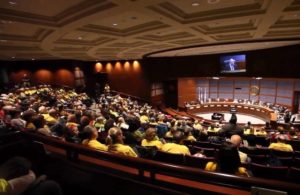 Meanwhile, the Planning Commission is set to finally weigh in on the contentious population density proposal this Thursday, after delaying a vote following a five-hour-long public hearing on Jan. 23.
Meanwhile, the Planning Commission is set to finally weigh in on the contentious population density proposal this Thursday, after delaying a vote following a five-hour-long public hearing on Jan. 23.
The proposed amendment to the zoning ordinance would increase the maximum allowed population per acre in the Planned Residential Community (PRC) district — Reston’s primary zoning district — from 13 persons to any number up to 15, along with allowing residential development at a density of up to 70 dwelling units per acre in certain areas.
Images via Fairfax County/Eventbrite and Reston Association/YouTube
 Laurie Tyler Dodd, a lawyer in Reston, is the third Democratic candidate to enter the race for the Hunter Mill District seat on the Fairfax County Board of Supervisors.
Laurie Tyler Dodd, a lawyer in Reston, is the third Democratic candidate to enter the race for the Hunter Mill District seat on the Fairfax County Board of Supervisors.
Dodd is running on a campaign to maintain low density outside the Reston transit corridor, according to a Facebook post she wrote on Jan. 17. Reston’s density has recently been the focus of a contentious zoning proposal that would increase the maximum allowed population per acre in the Planned Residential Community district from 13 persons to any number up to 15.
Other major issues she wants to address include:
- preserving Vienna’s “small town feeling”
- protecting the environment
- ensuring the district is “welcoming to all and supportive of its families and business”
The Washington Post reported that Dodd joined the race as a Democrat before Hunter Mill District Supervisor Cathy Hudgins announced on Jan. 22 that she won’t seek re-election this year.
Dodd currently is an attorney primarily practicing in Loudoun and Fairfax counties, according to her LinkedIn. She represents the best interests of children, addressing issues such as custody, visitation and foster care planning.
She has lived in Reston for 23 years.
Two Democratic candidates have already joined the race for her seat, Reston Now previously reported.
Shyamali Hauth, a United States Air Force veteran and community advocate, has her campaign focused on transportation, affordable housing, construction practices, budgets, security and education systems. Parker Messick, a recent graduate of Roanoke College, is running on a platform to “stop big development.”
The election for the county’s Board of Supervisors will take place on Nov. 5.
Photo via Laurie Tyler Dodd/Facebook
Dozens of Reston residents and locals showed up to testify in opposition to a contentious proposal that would increase the population density in Reston at the Fairfax County Planning Commission’s five-hour-long public meeting yesterday (Jan. 23).
The proposed amendment to the zoning ordinance would increase the maximum allowed population per acre in the Planned Residential Community (PRC) district — Reston’s primary zoning district — from 13 persons to any number up to 15.
It would also allow residential development at a density of up to 70 dwelling units per acre — the current maximum is 50 dwelling units per acre — for properties designated for high density on an approved development plan and located in a transit station area planned for mixed-use within the Reston PRC District.
Shortly before the meeting ended at 11:55 p.m., Vice Chairman and At-Large Commissioner James Hart deferred a decision on the item until Feb. 13.
Hart, the main person leading the proposal, started the meeting by telling his fellow commissioners and the audience that opposition to raising the density cap was a common theme of the many letters he received: “That message came through loud and clear.”
Yet, the commissioners still face a “nuanced” dilemma, from complicated numbers to whether it is better to raise the cap so that applications can come in as PRC or deal with applications zoned as PRM or PDC after the current PRC zoning is used up, he said.
Regardless of the future decision, he said he hopes that the controversy over the amendment “can spark interest and participation in the land use process.”
Most of the 29 who testified on what that decision should be urged the commission to reject the amendment.
Opponents — many of whom wore yellow clothing to symbolize their unity against increasing the density — said raising the density cap will jeopardize green spaces, worsen traffic congestion, crowd schools and encourage development before infrastructure is in place.
Many residents also voiced criticism that the proposal to raise the density cap was made without adequate community input and is based on faulty numbers.
Dennis Hayes, the president of the Reston Citizens Association, testified that county staff worked on the PRC amendment over a short summer and only held information meetings with the community.
“Meetings we were told would happen never occurred,” he said. He noted that the difference between a PRC capped at 13.7 versus 14.2 has not been demonstrated.
Roughly half of a dozen people spoke in support of the amendment.
Mark Ingrao, the president of the Greater Reston Chamber of Commerce, argued that the amendment encourages balanced growth under the Reston Master Plan.
“The Reston Master Plan process was well thought out,” Ingrao said, adding that it requires infrastructure to be phased-in with development — not happen beforehand. “The idea that streets and schools get built before people can use them is incongruent with the rest of the county.”
Ingrao also said that concerns about an exploding population are overhyped. “It took over 50 years to reach [Reston’s] current population, and it will take decades to achieve full buildout under the plan,” he said.
Mike Jennings, a Reston resident of 33 years, pushed back on the notion that the comprehensive plan did not include community involvement and that the Reston Planning and Zoning Committee is easily swayed to developers’ desires.
Jennings warned the commissioners to “be careful before assuming the very visible and vocal opponents of this amendment are representative of Reston.”
The record will remain open for public comments until Feb. 13.
Hart ended the meeting by saying that he’s learned from the mistake of separating zoning and planning and that in the future, the two must get planned together. “We’ve left ourselves a real mess,” he said about the current state of things.
Photos via Planning Commission
 This letter was submitted by Terry Maynard, who resides in Reston. It does not reflect the opinions of Reston Now. We publish article and opinion contributions of specific interest to the Reston community. Contributions may be edited for length or content.
This letter was submitted by Terry Maynard, who resides in Reston. It does not reflect the opinions of Reston Now. We publish article and opinion contributions of specific interest to the Reston community. Contributions may be edited for length or content.
As a Restonian who has worked hard on Reston planning and zoning for more than a decade, I was stunned by the letter mentioned in a recent Reston Now article. It was signed by 17 people — many of whom are associated with the leadership of the Greater Reston Chamber of Commerce (GRCOC) — to Hunter Mill District Supervisor Cathy Hudgins.
One of the most stunning claims in the letter was that “Reston’s Comprehensive Plan was the product of a five-year planning process involving the full community.” The fact of the matter is that the Reston community was marginalized throughout this timeframe, and its contributions were opposed by developers and ignored by the county.
No community representative, then or now, has opposed reasonable residential and commercial development in the transit station areas. They have objected and continue to object to the excessive development proposed by private and county land use interests.
Only six of the two dozen primary members of the RTF studying Phase 1 for the transit station areas were Reston residents who represented the interests of Reston residents. They included representatives from three community organizations — Reston Association, Reston Citizens Association and Alliance of Reston Clusters and Homeowners — and three independent “at large” residents.
The Task Force recommended 27,932 dwelling units — homes for about 59,000 people — in the station areas based on a study of multiple density and mix scenarios — a development level community representatives could live with. That was set at 27,900 when the Board of Supervisors (BOS) approved the Phase 1 plan in early 2014 — a number Reston community representatives could live with.
Then that Phase 1 planned station area dwelling unit number was raised by more than half to 44,000 dwelling units — 92,000 people — in mid-2015 by the BOS in the process of approving the Phase 2 plan without any community involvement or even foreknowledge. Yet the county insists it only revises plans every five years.
Community involvement in Reston planning was even more limited during Phase 2 for Reston’s suburban areas. It included only four county-led and controlled community meetings and an open house. It was agreed that residential areas should remain “stable,” but the redevelopment of Reston’s village centers drew controversy. Draft county language to require a comprehensive plan amendment to redevelop village centers was dropped from the Board-approved mid-2015 Reston Master Plan because it would make the redevelopment approval process more cumbersome. This effectively shut off public comment on critical changes and eases development.
No meaningful commitment was made in the Reston Master Plan to provide needed infrastructure on a timely basis, despite the GRCOC letter saying, “The Plan requires that infrastructure be ‘phased’ with development.” In fact, that is illegal in Virginia and the RMP planning principles say it “should occur with development.” Language about specific infrastructures–transportation, schools, parks, etc., is vague and the proposals are inadequate.
Moreover, no meaningful funding has been committed to building any of the so-called “planned” infrastructure elements, which are all generally inadequate against even county policy standards, excluding the library where a $10 million bond funding may disappear in 2022.
Now the county is proposing to amend the Reston Planned Residential Community (PRC) zoning ordinance to increase allowable community-wide population density from 13 to 15 people per acre in suburban Reston and increase the allowable density on a single PRC property designated “high density” from 50 to 70 dwelling units per acre, including the village centers and several so-called “hot spots.” In its staff report on the proposed zoning density change, the county calculates roughly a quadrupling of planned housing in the village center areas from less than 1,500 to 5,800.
It also identifies three suburban residential “hot spots”– Saint Johns Wood, Charter Oaks and Fairway — for high-density redevelopment that would more than double the number of dwelling units to 1,863 residences.
The bottom line is that Restonians have had — and continue to have — limited access to the planning and zoning process throughout and their contributions and concerns have almost universally been ignored.
The cumulative effect of the new zoning in the station areas and the prospect of increasing the Reston PRC zoning density would be to allow Reston’s population to triple from its current 63,000 people to more than 180,000. At the same time, there is little or no assurance of the arrival any time soon of needed infrastructure that would maintain Restonians’ quality of life as a model planned community.
Now it is imperative that Restonians rise up and stop the county’s ill-considered PRC density increase proposal driven by Supervisor Hudgins. Attend the Planning Commission hearing on the PRC amendment at 7 p.m. on Jan. 23 in the Fairfax County Government Center wearing a yellow shirt. The presence of hundreds of Restonians will be as great a message to the Planning Commission as the testimony of Reston’s representatives and residents.
— Terry Maynard
File photo
 This letter was submitted by Bruce Ramo, a member of community groups Reclaim Reston and Coalition for a Planned Reston. It does not reflect the opinions of Reston Now. We publish article and opinion contributions of specific interest to the Reston community. Contributions may be edited for length or content.
This letter was submitted by Bruce Ramo, a member of community groups Reclaim Reston and Coalition for a Planned Reston. It does not reflect the opinions of Reston Now. We publish article and opinion contributions of specific interest to the Reston community. Contributions may be edited for length or content.
It’s a lot to ask of everyone in Reston to understand the minutiae of land use law. We have families and jobs and other responsibilities. And, after all, we chose to live in a planned community with loads of covenants and design guidelines. We can leave it to the “experts.” Except we can’t.
Like it or not Restonians have little say over how our community is being developed, and the elected official who should be watching out for us, our county supervisor, has retreated to a defensive posture. She frequently tells us “we just don’t understand” and has suggested that Reston, perhaps the most progressive community in Virginia, opposes the proposed increase in the density cap out of fear of “the other” sharing our neighborhoods. This is simply untrue. The community group Coalition for a Planned Reston proposed an increase in the required affordable housing levels for Reston–our supervisor did not support us.
So what’s the big deal about increasing the density cap, from 13 to 15 persons per acre, in the primarily residential areas of Reston called the Planned Residential Community district? The supervisor and county staff tells us that the increase is necessary to implement 2015 changes to the Reston Master Plan. Those changes allow significantly increased density in the Village Centers and other “hot spots” throughout established neighborhoods of Reston, far from the Metro stations. We are also scolded about speaking up now because, as the story goes, the public had lots of opportunities back in 2014-15 to comment on changes to these portions of the Reston Master Plan changes called “Phase 2.” (Phase 1 involved only the transit station areas.)
Our supervisor and county staff frequently repeat the myth of significant community involvement in Reston Master Plan Phase 2. However, the county disbanded the citizen “task force” set up for community review before the Phase 2 review. There simply was little in-depth public review of the changes that are the driver for increasing the density cap.
Why should you care? Because if the zoning density cap is lifted, the ability of the community to push back on significant high-density development in our established residential neighborhoods effectively will be eliminated. Sure, each of us can watch out for individual development applications, but the force of overall community oversight based on a reasonable density cap will have been taken from us forever.
We have invested our financial resources, identities and emotional loyalty to Reston as a planned community. The density increase is an existential threat to those investments.
Take action to protect your hometown. Help maintain the current density cap and the modicum of control it provides over those who would rob us of a community grounded in diversity, environmental stewardship and quality of life.
Attend the Jan. 23 meeting of the Planning Commission at the Fairfax County Government Center at 7 p.m. (and wear your yellow shirts!)
Write to our County officials: Supervisor Hudgins: [email protected]; other Fairfax County Supervisors: [email protected]; and the Fairfax County Planning Commission: [email protected].
File photo
The Fairfax County Public School’s Capital Improvement Plan (CIP), scheduled for review later this month, still leaves a planned nearby high school unfunded as local crowding increases.
The new high school is planned for somewhere along the Dulles Suburban Corridor to take students coming up through McNair, Coates and Hutchison elementary schools.
The high school’s location has not been selected yet, and school officials at prior meetings said they are relying on proffers from developers and negotiations with applicants to see if land for a new high school can be provided.
While South Lakes High School sits at 92 percent capacity, the surrounding Herndon, Madison and Oakton high schools all exceed 100 percent capacity. The CIP’s school capacity chart for the 2018-2019 school year shows Oakton High School at 131 percent capacity. The school year 2023-24 projections show South Lakes High School’s capacity increasing from 92 percent to 97 percent.
The CIP also notes that capacity enhancement additions will be needed at Madison High School to accommodate for the forecasted capacity needs, though those additions remain unfunded.
The high school planned for the western party of the county to relieve schools around Oakton and Herndon is not the only new school lacking funds. A new elementary school along the Metro’s Silver Line also remains unfunded.
As plans move along for greater levels of residential density in Reston, local residents expressed concerns at meetings last year that FCPS is waiting until new development starts to overcrowd the schools before taking action to address capacity. School officials stated that the new developments are not anticipated to bring in high numbers of new students.
A public hearing for the CIP will be held next Tuesday (Jan. 8) before a final decision, which is scheduled for Jan. 24.
Photo via FCPS
Updated at 5:00 p.m. — Corrects the spelling of Laurie Dodd’s name and the time of the Planning Commission meeting on Jan. 23.
Reston Association’s Board of Directors unanimously voted to continue its opposition to a proposed zoning amendment, which would increase Reston’s population density, at last night’s meeting.
The proposal would increase the maximum allowed population per acre in the Planned Residential Community (PRC) district — Reston’s primary zoning district — from 13 persons up to 15.
After an executive session to consult with the land use counsel, Vice President Sridhar Ganesan said that the current density at 12.46 people per acre is a “very inaccurate population estimate.”
“A lot of slack is built into the current density,” Ganesan said. “I believe the director of the Planning and Zoning Commission told us –some of the members on the board — they are trying to recalculate the population estimate in Reston, and they don’t have an accurate estimate just yet.”
Given the wiggle room in the current density and the outrage from many community members, Ganesan said the PRC density level should not increase.
Several community groups, including the Coalition for a Planned Reston and Reston 2020, are fighting the move, arguing that the proposed amendment is rushed through and under-explained.
County planning officials have argued that the change is needed to put into action Reston’s Master Plan, which allows for future growth over the next 40 years.
President Andy Sigle said that the RA is still working through “reams” of data and information in support of the zoning proposal from a series of emails on Dec. 11 from Fairfax County.
“We have a concern that the wrong number on this PRC density will overwhelm the infrastructure prescribed in the Reston Master Plan, so it’s important that we get the right number,” Sigle said at the meeting.
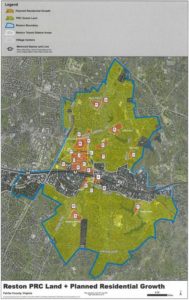 The board also approved setting up a work session for RA’s board prior to the Planning Commission’s Jan. 10 workshop on the amendment.
The board also approved setting up a work session for RA’s board prior to the Planning Commission’s Jan. 10 workshop on the amendment.
Fairfax County’s Board of Supervisors clashed over community input on the proposed zoning changes at their Dec. 4 meeting, before authorizing public hearings on the proposal.
Hudgins said at the Dec. 4 meeting that locals have had plenty of opportunities to get the desired information. “Yes, there are some questions that people have,” Hudgins said. “Those questions have been answered before or are not relevant to this.”
Meanwhile, Dranesville District Supervisor John Foust and Braddock District Supervisor John Cook argued for more community input.
Residents expressed frustration and disapproval to RA’s board last night (Dec. 13), pointing to a lack of community input to the county’s board and insufficient infrastructure to support increased density in Reston.
Laurie Dodd, a resident for the last 23 years, criticized Hunter Mill District Supervisor Cathy Hudgins for asking to schedule hearings on the zoning proposal without following through on promised community engagement.
“It is disturbing to me to see other supervisors in Fairfax County speak up about the right of residents to be heard more than our own supervisors had done,” Dodd said.
The Planning Commission is scheduled to hold a public hearing about the zoning proposal at 7 p.m. on Jan. 23, followed by the Board of Supervisors’ public hearing at 4:30 p.m. on March 5.
The Planning Commission must say “yea” or “nay” to the proposal by March 15, according to county rules.
Secretary John Mooney urged Restonians to stay informed and engaged. “Please attend the county meetings,” he said.
Photo via Reston Association/YouTube
This story has been updated
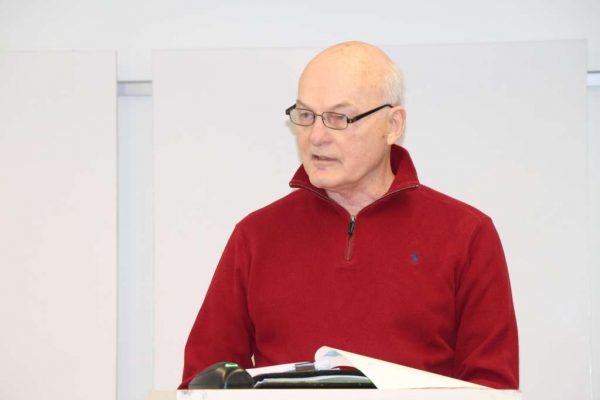 This is an op/ed submitted by Terry Maynard, co-chair of the Reston 20/20 committee. It does not reflect the opinions of Reston Now.
This is an op/ed submitted by Terry Maynard, co-chair of the Reston 20/20 committee. It does not reflect the opinions of Reston Now.
Reston’s future lies largely in the numbers that define the county’s plan for Reston’s transit station areas (TSAs)–the areas roughly within a half-mile of each Metro station. The results of looking at those numbers are shocking, but not really surprising.
The Board of Supervisors-approved Reston Master Plan calls for 44,000 dwelling units (DUs) in Reston’s TSAs, virtually all of which will be high-rise (“elevator”), high-density DUs–condos and apartments.
County planning assumes 2.1 people will live in each high-rise, high-density DU.
Put together, that means a potential population of 92,400 people in Reston’s station areas. That’s without any affordable housing “bonuses” or development waiver approvals or other uncounted DUs or people, a frequent fact of life in Fairfax County.
When the Reston Master Plan Task Force was working on a new plan for the station areas, the county provided several different numbers for the actual acreage of the study area. These ranged from 1,232 acres (1.925 square miles) to 1,683 acres (2.630 square miles) of land in Reston’s TSAs. The county provided no explanation for the range of values.
Dividing the number of people by the acreage, the resulting number is somewhere between 55 and 75 per acre. On a square mile basis, that Reston TSA density is between 35,200 and 48,000 persons per square mile (pers/SM).
According to Wikipedia, Manhattan has a density of 26,403 pers/SM. That makes the planned population of Reston’s TSAs at least one-third denser than and potentially nearly twice as dense as Manhattan is today.
Wikipedia adds that Manhattan’s residential density “makes it the densest of any American municipality with a population above 100,000.” And Reston’s TSA population may well exceed that 100,000 number if the county continues its bonus and waiver giveaways to developers.
I don’t think anyone who lives in Reston thinks that two square miles of super-density in Reston’s TSAs cutting through the middle of our community is consistent with any definition of preserving, much less improving, Reston’s quality of life. And the county has no meaningful plans or means to meet the infrastructure requirements of this population or the needs of the surrounding Reston community.
 Reston’s ongoing impassioned debate on a move by county officials to change zoning rules to allow for more development will come to The Kojo Nnamdi Show today.
Reston’s ongoing impassioned debate on a move by county officials to change zoning rules to allow for more development will come to The Kojo Nnamdi Show today.
Hundreds of Restonians packed a public meeting earlier in late October to oppose the change, which many said opens up the area to further development without ensuring adequate infrastructure is already in place for current residents. Roughly 900 residents packed the meeting room after the first meeting was postponed due to an overwhelming outcry and burgeoning attendance from the community.
The show, which is on WAMI 88.5, a NPR member-station in Washington, will air at noon today. The segment is titled, “Growing Pains: Reston, Virginia Debates New Limit on Population Density.” The show issued the following description, which paints Reston’s debate as a microcosm of national development issues:
Developers and new residents are eying Reston, Virginia, and Fairfax County officials want to change zoning rules to allow them to move in. But in a trend that is playing out across the region, many long-time residents say their community is becoming too urban too fast. Critics are opposing a proposed change to a zoning ordinance that would raise the current population cap of 13 persons per acre to 16. And so many residents showed up to a meeting to discuss the change that it had to be rescheduled. Kojo explores Reston, Virginia’s growing pains and the difficulty of maintaining a suburban feel in a highly desirable, rapidly-growing region.
Restonians can listen to the program when it is live on the radio at 88.5 FM or online at kojoshow.org. Listeners can also participate by calling 1-800-433-8850, emailing [email protected], or tweeting at @kojoshow.
Reston's officials want to raise its residents-per-acre limit. Many residents don't. What say you?https://t.co/tBD5L6YYr2.
— The Kojo Nnamdi Show (@kojoshow) November 15, 2017
 This is an op-ed by Terry Maynard of Reston 2020. It does not represent the opinion of Reston Now.
This is an op-ed by Terry Maynard of Reston 2020. It does not represent the opinion of Reston Now.
As you were enjoying your summer, probably including a family vacation, our County leaders were — and are — planning to increase the allowable density in Reston’s transit station areas (TSAs) again through amendments to the zoning ordinance.
The reason: Fairfax County is running out of ways to generate taxes to cover its expenses as job growth and development falter. At this point, so close to another local election, they are neither ready to increase our taxes nor cut well-liked programs (other than parks and libraries, of course).
They have to add more taxable property — residential and commercial — to drive up revenues. And Reston and Tysons are the places they intend to do it.
The County’s Zoning Staff is preparing to allow increased Reston density in two ways.
In Reston alone, the County staff is planning to increase (or eliminate) the maximum allowable population per acre in the Reston Planned Residential Community (PRC) — a zoning category.
According to the Fairfax County’s demographer’s count, Reston now has a population of less than 62,000, about 10 people per acre. Reston’s current limit is 13 persons per acre for a total population of about 81,000 according to a county briefing. Using absolutely absurd “household population factor” values (ostensibly the typical number of people in a household by type of household), the zoning staff has put Reston’s population at more than 73,000 people or 11.7 people per acre (10 percent available capacity).
We are, in fact, more than 30 percent short of that capacity. Yet, if the “cap” is increased or deleted, it creates more “flexibility” for developers, which as the next paragraph will show, is the goal. Read More


